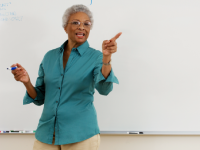The Nuts and Bolts of Explicit Modeling
Although many other methods of teaching are noteworthy -- such as case study, problem-based learning, and simulation -- many scholars agree that students need "careful, personal instruction with clear demonstrations in reading and writing", as well as in social studies, math, and science. (Note: NCTM membership is required to view this math link.)
What can instructional modeling teach?
- Concepts
- Skills
- Performances
- Attitudes
- Behaviors
- Dispositions
- Thinking
"Most human behavior," according to Stanford professor Alfred Bandura, "is learned observationally through modeling." As evidence, watch Bandura’s controversial Bobo Doll Experiments where children, after witnessing adults assault a wobble clown, follow suit.
Several instructional methods incorporate teacher modeling:
- Cognitive apprenticeships: Showing students how to do something within an authentic context while making the thinking behind the procedure visible
- Demonstrations: Planning, introducing a lesson, presenting, giving a performance, and summarizing
- Worked examples: Solving a problem and writing out the steps (PDF, 197KB)
- Think alouds: Modeling metacognition by stating aloud everything an instructor thinks while reading aloud (PDF, 11KB)
I detail other modeling approaches below.
Planning Tips
Modeling necessitates meticulous planning. Start with assessment to identify areas of greatest need. After identifying a skill or concept to model, anticipate areas that are most likely to confuse learners. If the skill is particularly difficult, try the following:
- Narrowing the steps
- Breaking the skill down into two or more chunks and modeling them over the next few days
- Modeling with an easier text to teach point of view (like Jon Scieszka and Lane Smith's The True Story of the Three Little Pigs instead of Virginia Woolf's Mrs. Dalloway)
- Preparing to model the procedure more than once, especially in a group including English-language learners and students with learning difficulties
- Asking more questions by writing down "check for understanding" questions in advance to reduce the number of details you have to juggle
Right Before Modeling. . .
I generally do three things in front of students before modeling a skill.
1. Review the previous lesson.
Example: "Yesterday, we learned how to add integers. There were three things we practiced. Who can tell me what those three things were? Today we are going to __________."
2. Introduce learning goals.
Example: "I'm going to teach you to/about __________. This skill/concept will help you __________. By the end of this demonstration, you'll be able to __________."
3. Introduce steps (in writing) and check for understanding.
Example: "So in this demo, we'll do __________ first, then __________, and then __________. Is there anything you want me to clarify before I start? Bob, tell me what you'll be able to do at the end of this lesson and why."
Explicit Modeling
Explicit modeling (EM), supported by ample research, works best for modeling facts and procedures that require precision, such as math and grammar. In the eight steps of EM, summarized in this PDF (44KB), the teacher:
- Breaks down the concept or skill into critical features or elements
- Clearly describes the concept or skill
- Clearly models the concept or skill
- Provides multi-sensory instruction (visual, auditory, tactile, kinesthetic)
- Thinks aloud as she or he models
- Models examples and non-examples
- Works with cues (pointing, circling, or highlighting)
- Provides high levels of teacher-student interaction (Source: MathVIDS)
I yield to criticism that EM is teacher centered and teacher directed, two overused and maligned classroom paradigms. Furthermore, I agree that the goal for any instructor is to shift students into more agentive, self-directed behaviors.
What EM does effectively, however, is lighten extraneous cognitive load, or mental effort -- a whopping benefit of the method. Heavy loads impact completion (my mom tries to use Facebook every two months, but because I've neglected to help her master that skill step by step, she'll never rejoice at uploaded photos of my crockpot masterpieces).
The equation: EM = decreased cognitive load = task completion.
After Modeling
Allow plenty of time for students to review and practice soon after the concept or skill has been demonstrated. Studies suggest that students compare their work with an expert's (such as the teacher) to improve learning (PDF, 197KB).
One math instructor I know models how to solve a problem, then assigns a related problem on the board for everyone to complete independently. If only a handful of students complete the problem perfectly, he asks them to write down the steps they took and explain them in small groups.
Karen Lea writes: "Modeling means that the teacher does most of the work the first time, and then gradually the students do most of the work" -- a research-supported approach (PDF, 1.3MB) referred to as the gradual release of responsibility (GRR). After the instructor demonstration, the following occurs in GRR:
- Shared experience: The class collaborates with the teacher to work through the skill.
- Guided practice: Students apply the skill with the support of peers, often while being observed by the teacher.
- Independent practice: Students apply the skill on their own.
Monica Baines models GRR in this video.
Advanced Degree of Difficulty
While instructors often monitor students as they struggle with a new problem, learners rarely watch instructors take the same risk, thereby perpetuating the myth of teachers' intellectual supremacy. In real time, while students observe, try formulating and attempting to answer questions related to an historical artifact, or try writing a poem from scratch in front of the class, or try testing a new scientific hypothesis.
The payoff? You'll model grit.
Finally, keep your expectations of students high. They may struggle, but will nevertheless benefit from clear modeling and your faith in their abilities.
Please share your own modeling tips.
